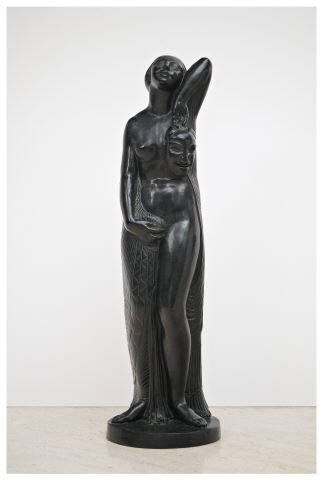
- 1926
- Bronze
- Patined bronze
- Inv. 81E438
Canto da Maya
Comédie (“Femme au Masque”)
Comédie forms a pair with Tragédie, which also belongs to CAM’s collection. Both pieces were presented at the prestigious Salon d’Automne in Paris in 1926. The allegorical, and very symbolist, subject was habitually treated in a conventional way, in contrast to the highly personal touch imparted to it by Canto da Maia, whose approach was noted by a French critic who declared «first he surprises and then he seduces».* Small in size, the female figure with a mask in her hand revisits the iconography of Thalia, the Greek muse of comedy and idyllic poetry, a doubling which is suggested by her lyrical and smiling expression. The Hellenic inspiration was further reaffirmed in the archaizing modelling of the body, very much in keeping with the era, in a sober monolith of bronze, with the hair and clothes being schematised in a manner reminiscent of the Archaic Period of Greek statuary.
The smooth and rippling contours of the outline, the simplicity of the forms, the elegant pose and the refinement of the gesture reveal an incipient taste for the language of art déco, which was rising to prominence at the time. Canto da Maia found himself perfectly in tune with the new artistic trends imposed by Paris, the city which he embraced as home for most of his life, although he always retained a certain exoticism considered to have been characteristic of the Portuguese.
Comédie is a work of maturity, created in the year in which he began his career as an independent artist, and a few months before he definitively adopted the pseudonym Canto da Maia. The works that he created at the time achieved great success in the French capital, receiving praise from critics and invitations to collaborate with important artistic figures such as Mallet-Stevens and Paul Follot. However, for the Portuguese his name would above all come to be associated with his participation in the Estado Novo’s great campaigns of official statuary, deifying the heroes of the nation, which, in turn, repaid him with several much-deserved public honours.
Afonso Ramos
May 2010
* Quoted in Ernesto Canto da Maya: Sculpteur Portugais XXe Siècle: un sculpteur des Açores dans le Paris des années trente, Paris, Centre culturel Calouste Gulbenkian, 1995, p. 105.
| Type | Value | Unit | Section |
| Height | 157,5 | cm | |
| Width | 49 | cm | |
| Depth | 47,5 | cm |
| Type | signature |
| Type | other |
| Type | other |
| Type | A definir |
| Arte Contemporáneo Portugués |
| Lisboa, Fundação Calouste Gulbenkian, Centro de Arte Moderna, 1987 |
| Catálogo de exposição |
| Canto da Maya |
| Centre Culturel Calouste Gulbenkian |
| Curator: Paulo Henriques |
| 9 de Fevereiro de 1995 a 6 de Abril de 1995 Centre Culturel Portugais/FCG, Paris |
| Exposição patente de 9 de Fevereiro a 6 de Abril de 1995 |
| Arte Contemporáneo Portugués |
| Fundação Calouste Gulbenkian |
| Curator: CAM/FCG |
| Fevereiro de 1987 a Março de 1987 Madrid, Museo Espanõl de Arte Contemporáneo |
| Exposição organizada pelo CAM e pelos ministérios dos "Asuntos Exteriores" e da Cultura de Espanha. A exposição apresentou obras da Colecção do Centro de Arte Moderna e de colecções particulares. |
| Le XXéme au Portugal, Pintura, Escultura, Desenho, Tapeçaria |
| Fundação Calouste Gulbenkian |
| 1986 Bruxelas, Centre Albert Borschette |
| Bruxelas, 1986 |